Tara McPherson: Why are the Digital Humanities So White? or Thinking the Histories of Race and Computation
A Traditional Critical Analysis and A DH Textual Analysis using Voyant Tools

Tara McPherson’s question “Why are the Digital Humanities so White?” is the title of her article. McPherson argues that “the difficulties we encounter in knitting together our discussions of race (or other modes of difference) with our technological productions within the digital humanities (or in our studies of code) are actually an effect of the very designs of our technological systems, designs that emerged in post–World War II computational culture.” Digital humanities (DH) is an area of scholarly activity at the intersection of computing or digital technologies and the disciplines of the humanities (Wikipedia).
Why is McPherson’s question so important? If the digital humanities (DH) are mostly white, then whose interests are served, what texts are investigated and published, what questions are asked and answered, whose research is done? If whites are heavily represented, then whose voice is heard, what data is skewed because of only a partial picture, what is the focus of DH work and who is oppressed by that? There is a danger of hegemony where the dominant group speaks for all. If there is a white vs. non-white perspective as McPherson discusses, there is a class distinction and a gendered perspective, male vs. female, or non-male, perspective as well. There is a class of people who attend university or college and go on to become the teachers and professors, researchers, who write the text books. There is a proportionately higher number of influential men in the Science, Technology, Engineering, and Mathematics (STEM) fields where UNIX and other operating systems originated as well as in the digital humanities. McPherson’s argument ‘why’ is a comparison structured by a lenticular lens, a parallel of two separate systems, first one and then the other, but never a mixture of the two. She shows historically, how over time situations changed and the two systems, UNIX operating system and the oppressive social system race, became harder to work from within for those affected.
| UNIX | Race |
|---|---|
| 1969–beginning of UNIX | 1960s activism |
| operating system | social system |
| computer | people |
| technical | humanities |
| code studies | cultural and ethnic studies |
Her parallel structure is good for comparison as she talks about one concept, then the other, to compare how they bound their respective entities first in the mid 1960s and then much later on. McPherson’s article is helpful to explain the point of view to each group from the perspective of the other group.
Both the computer and the lenticular lens mediate images and objects, changing their relationship but frequently suppressing that process of relation, much like the divided departments of the contemporary university. The fragmentary knowledges encouraged by many forms and experiences of the digital neatly parallel the logics that underwrite the covert racism endemic to our times, operating in potential feedback loops, supporting each other. If scholars of race have highlighted how certain tendencies within poststructuralist theory simultaneously respond to and marginalize race, this maneuver is at least partially possible because of a parallel and increasing dispersion of electronic forms across culture, forms that simultaneously enact and shape their new modes of thinking (13).
First, I will critically analyze McPherson’s article with two supporting documents. Next, I will use a DH tool, Voyant, to analyze the articles that provides statistics about them. My two supporting articles are Peggy MacIntosh’s “White Privilege: Unpacking the Invisible Knapsack” and Thomas Rommel’s “A Companion to Digital Humanities”. I use my coursework in sociology, women’s and gender studies, digital humanities, and programming experience from Computer Science and Mathematics in my analysis. Then I offer a summary and final comments.
Traditional Analysis of Texts
Sociological Lens
Social scientists use a variety of techniques (e.g., surveys, experiments) to help them “see” the social world (Brym: 525). At first most [social scientists and policymakers] believed that the Internet would enhance equality of access to information by reducing its cost. As technoeuphoria wore off, however, observers noted that some kinds of people used the Internet more than others and that those with higher access also had greater access to education, income, and other resources that help people get ahead (DiMaggio: 549). Higher education “has always been closely related to social-class background” (Brym: 328). At one Canadian university “students [e.g., women, Jews, Ukrainians, Poles, Dutch, Norwegians, Germans, Italians, and Mennonites at the University of Manitoba] needed much higher marks than the “preferred” students [who] were Anglo-Celtic Protestant and Catholic (Brym: 329). Conflict theory views society as a site of struggle between groups with different kinds and amounts of power and resources…Groups with more power are likely to control schooling and to impose their culture on it (Brym: 322). “Conflict analysis draws attention to the question of whose knowledge is reflected in schools, and which groups are served by the norms that schools foster” (Brym: 323). “Schools, like the society, are controlled by the relatively powerful, educational change depends on change in relations of power outside the school system” (Brym: 324). Unequal power relations result in economic inequality, class difference, and dominance through schooling for people (Brym). “As the institutional means of power and the means of communications that tie them together have become steadily more efficient, those now in command of them have come into command of instruments of rule quite unsurpassed in the history of mankind” (Mills, 2007: 97). We see that schools are a powerful place that affect a person for life and in turn that person can influence others. If a certain group of people have limited access to education and tools, then the full potential of the population cannot be reached. Therefore, McPherson’s question is so important so this can change, DH can be inclusive not exclusive as it appears to McPherson.
Feminist Lens
Race and Gender Inequalities–A Hierarchy of Race and Gender “Humans … naturally favour members of their own ethnic or racial group—their ‘relatives’—and have a natural distrust and dislike of ‘nonfamily’ members” (Brym: 221). “Power, prestige, and material well-being are often interrelated…historically, women have been excluded from certain types of activities that create opportunities for acquiring power, prestige, and wealth” (Brym: 190).
Feminism described as first, second, and third waves
McPherson uses a historical view and I include feminism in three waves to remind us of the connections of race, gender, technology, and the academy. The first wave of feminism (Henslin et al., 2007: 153) was the fight for the right to vote; the primary goal was the struggle to grant to vote to [certain women] middle class women, 1835-1920 (Crowe: 59, 60). The second wave of feminism, the rise of feminism in the mid 1960s along with other movements including the civil rights movement in the United States (Crow: 59). The third wave of feminism, late 1980s, 1990-1999 (Crow, 2009: 37, 59) brought out, uncovered, “the recognition that Canadian social institutions perpetuate racism” … and led to “epistemological questions of how to theorize the inter-connection between race and gender and continue to document how racial differences are created between women” (Crow: 37).
How education is delivered is important because the manifest function or intended purpose of formal education is knowledge, training students in reading, writing, and arithmetic, as well as many other subjects. “Canadians spend much of their lives in classrooms,” affected by “a hidden curriculum, in our schools … where the latent function of education, the inculcation of values that, though not explicitly taught, form an inherent part of a school’s message” (Henslin: 71). The hidden message, women are not good at nor found in STEM (Science, Technology, Engineering, & Mathematics https://www.ed.gov/stem ) classes compared to the Arts disciplines.
Structures responding to and marginalizing race - For feminism, there is no one woman’s story, but many stories, and class and race tell different stories for white and non-whites. The one/the other and the question is “Who benefits?” There is difference, the other is always in relation to the one, but the other can never be ‘the one’ unless we work together for change.
Article Analysis, Comments on A Parallel Structure of UNIX and Race
Unix and race are separate entities which McPherson looks at through a lenticular lens. She uses a parallel structure to explain why the digital humanities are so white.
- Structural separation, Department may refer to: Departmentalization, division of a larger organization into parts with specific responsibility (Wikipedia).
- About UNIX. UNIX embeds information, hiding it from users of the system but transparent to creators of applications. The application programmers cordon off users from areas of the program they do not want users to see or access or change. It does so by modularity and use of shell scripts and command line interpreter use by programmers.
Early Unix developers were important in bringing the concepts of modularity and reusability into software engineering practice, spawning a “software tools” movement (Wikipedia).
-
About RACE. Our bodies embody information such as race and culture. Judgements are made, e.g., by media, employers, according to visual representations. According to a structured hierarchy of white / other, where ‘white’ may be or is preferred and ‘other’ may or is not. The other are cordoned off and prevented from accessing jobs, services and/or programs that owners/managers of the system do not want them to access.
-
My supporting document to McPherson, is Peggy McIntosh’s White Privilege, Unpacking the Invisible Knapsack as she outlines the “Privilege: an invisible package of unearned assets that I can count on cashing in each day, but about which I was “meant” to remain oblivious”. McIntosh writes a numbered list advantages of being white that come implicitly in an ‘invisible knapsack’ that she has taken for granted as a white person. She shines a spotlight on the white privilege that most [whites] take for granted and do not notice. List of Daily Effects of White Privilege McIntosh - Daily Effects of White Privilege list (page 2). “One factor seems clear about all of the interlocking oppressions. They take both active forms which we can see and embedded forms which as a member of the dominant group one is taught not to see” (McIntosh). McIntosh writes “There was one main piece of cultural turf: it was my own turf, and I was among those who could control the turf.” This is the problem, control. As I wrote previously, who benefits? The controlling group control the turf and whether they recognize it or not this means perpetual barriers for non-whites.
-
Why were the digital humanities so white, sheds light on why are the 1% still so white? The system supports itself, ‘the master’s tools’ are white, the system, as McPherson points out, is structured so that it feeds the white and stifles the other, first overtly before the mid 1960s then covertly after that. White, upper class, educated men have the privilege to continue the system more easily than others. Efforts made to change the system happened. In the mid 1960s there were race riots and the second wave of feminism to counter act that male system of privilege. This is a political subject as those who controlled the Internet and early computers were the government and the military. The government still controls schools and education and the military. Who controls the media and networks but corporations who pay for air time through commercials and advertisements. Who controlled the government, education, and corporations but white, upper class, educated men.
- Changes came about from second wave feminism, to work toward gender equality and third wave feminism in the early 1990s brought many aspects including action and support for women of colour. Feminism could push back against inequity. People needed to recognize inequity and that is why I have included Peggy McIntosh’s paper on White Privilege, Unpacking the Invisible Knapsack. The goal is to break down the barriers to allow inclusion in the Digital Humanities, academia, or elsewhere. It must be done by those in control.
A Historical Look, Pre UNIX
I studied assembly language on a Von Neumann machine/processor, with do-it-yourself data structures carved out, with SAL, MAL, and TAL (True Assembly Language). One could argue that programming in assembly was complicated in that it required keeping track of the space used, being careful not to overwrite areas by keeping the data structures in the program ‘segregated’ manually in the program. One could also argue that it was simple, transparent, and hands-on.
UNIX and mid 1960s
The operating system Unix overtook Von Neumann’s machine programmed with asssembly language. UNIX had shells and used modularity, making it less open and accessible than previous opreating systems programmed with assembly language.
| Unix | Race |
|---|---|
| modular | overt racism |
| shell | segregation |
Late 1990s
| Unix, Java | Race |
|---|---|
| modular | covert racism |
| OOP | feedback loops further racism |
| classes | classes |
Analysis with Digital Humanities (DH) and Voyant Text Analysis tools
As Thomas Rommel writes,
The history of literary computing, however, shows that only a limited number of textual phenomena can be analyzed profitably in the context of quantitative and qualitative computer-based analyses of style. These phenomena have to be linked to some surface features that can be identified by electronic means, usually by some form of pattern matching. Computers are exceptionally well suited for this kind of analysis, and only human intuition and insight, in combination with the raw computing power of machines programmed to act as highly specialized electronic tools, can make some texts or textual problems accessible to scholars.
Article link: Thomas Rommel
An example:
This text analysis visualization, presents evidence that supports my core argument.
The text analysis tool I used was Voyant. Here is the text analysis document window after I pasted in the text from the article,
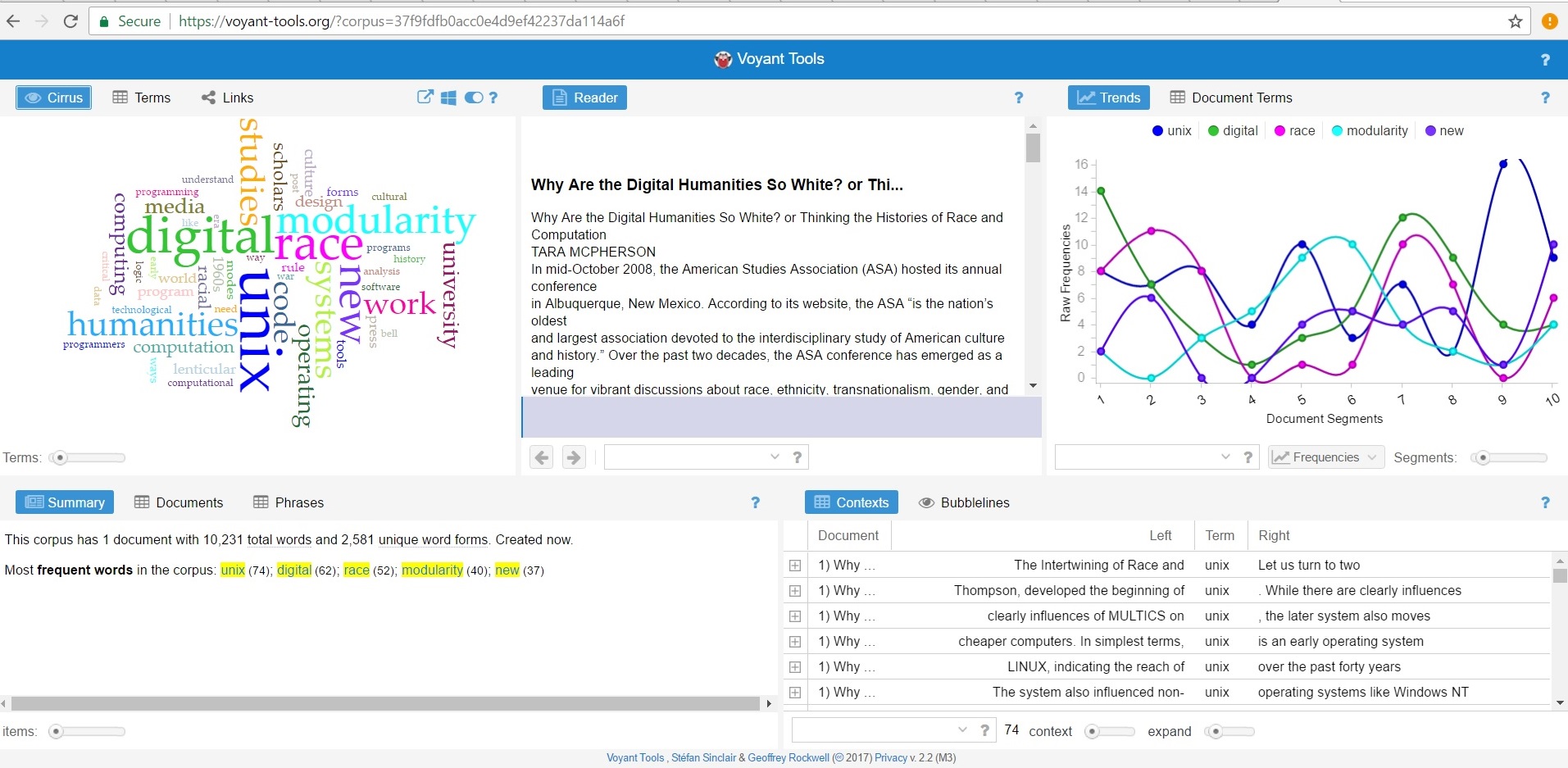 . The results of the text analysis: This corpus has 1 document with 10,231 total words and 2,581 unique word forms. Created now.
Most frequent words in the corpus: unix (74); digital (62); race (52); modularity (40); new (37).
. The results of the text analysis: This corpus has 1 document with 10,231 total words and 2,581 unique word forms. Created now.
Most frequent words in the corpus: unix (74); digital (62); race (52); modularity (40); new (37).
- In the word map of the text the size of the text is in direct proportion to the number of times the word is found in the corpus. The corpus, or the text in the document is shown between the word map and the graph. The curves in the graph show the analysis of the word count of the corpus, the article by McPherson. Following is the Voyant text analysis of Peggy McIntosh’s article:
Voyant Text Analysis of Peggy McIntosh’s White Privilege
This corpus has 1 document with 2,566 total words and 796 unique word forms. Created 2 seconds ago. Most frequent words in the corpus: privilege (31); white (22); race (18); advantage (15); work (15)
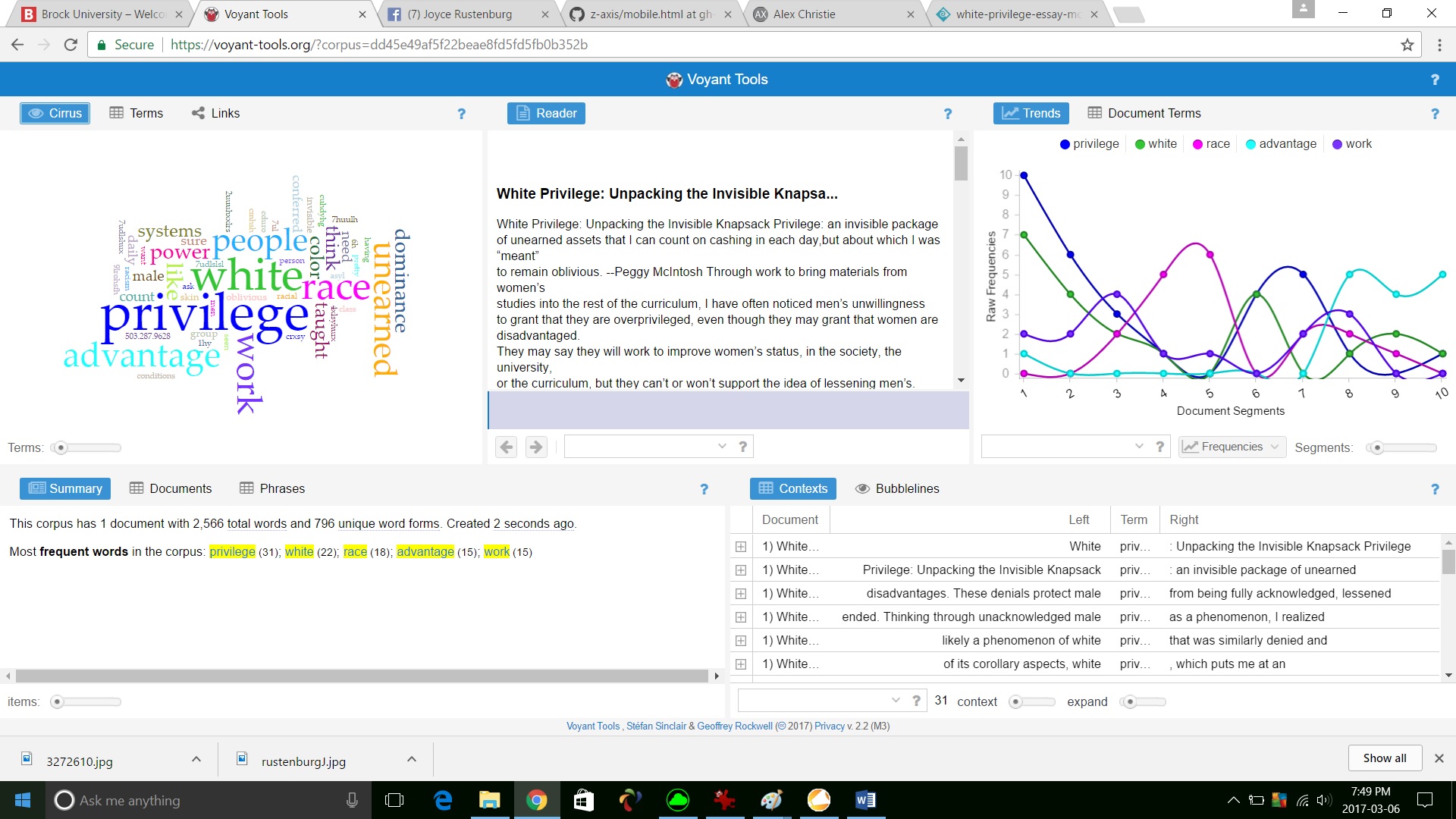
| McPherson - Word cloud | McIntosh |
|---|---|
| overt and covert racism | white privilege sustains racism |
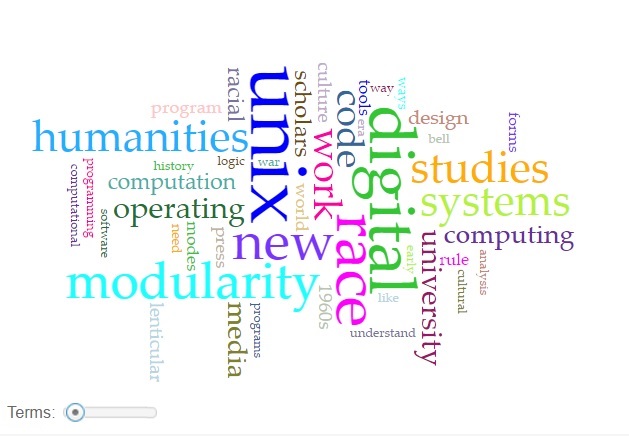 |
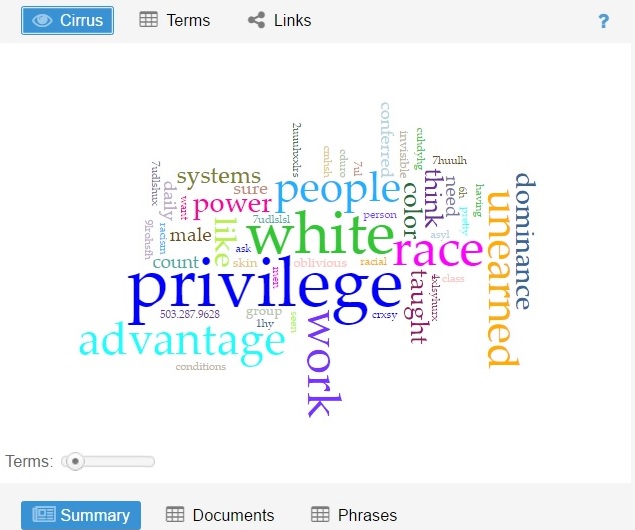 |
| McPherson - Graph | McIntosh |
|---|---|
| overt and covert racism | white privilege sustains racism |
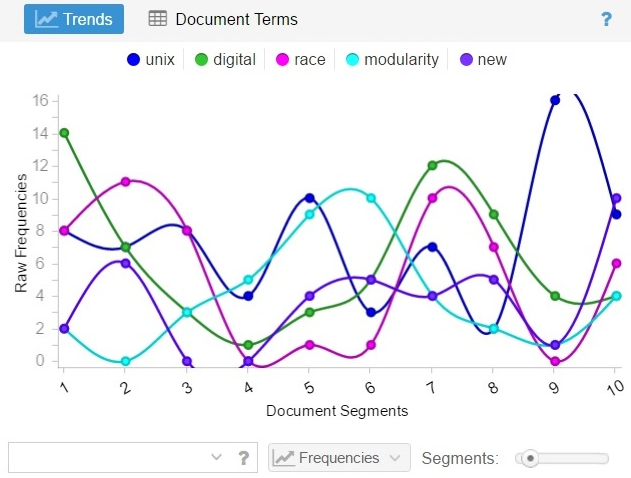 |
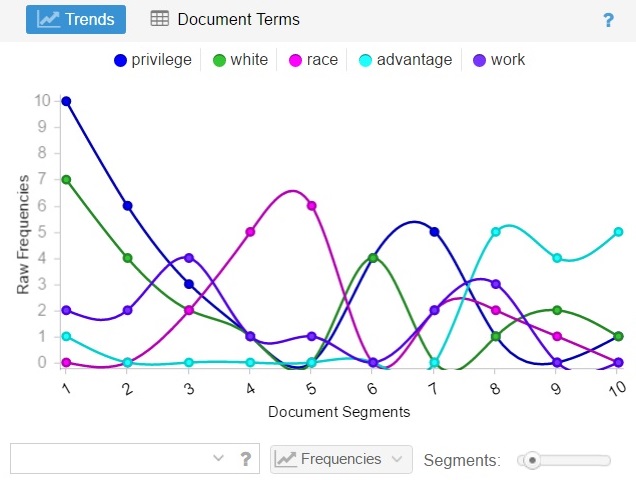 |
Voyant analysis of Rommel’s text
This corpus has 1 document with 3,800 total words and 1,126 unique word forms. Vocabulary Density: 0.296
Average Words Per Sentence: 30.4
Most frequent words in the corpus: literary (60); studies (45); texts (36); analysis (35); computer (31)
| Rommel’s - Word cloud | Rommel’s - Line Graph |
|---|---|
| freq. by font size | freq. by line graph |
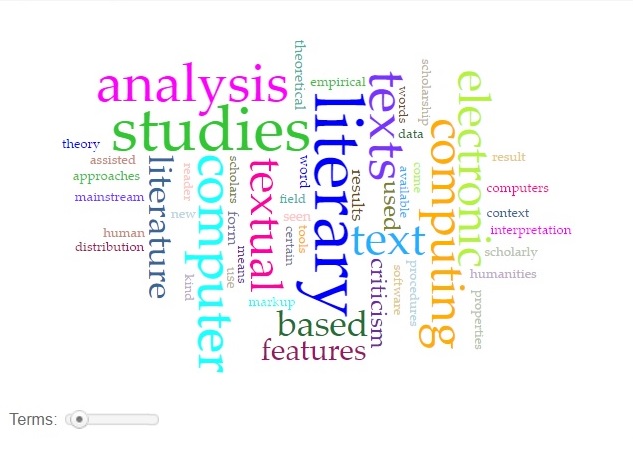 |
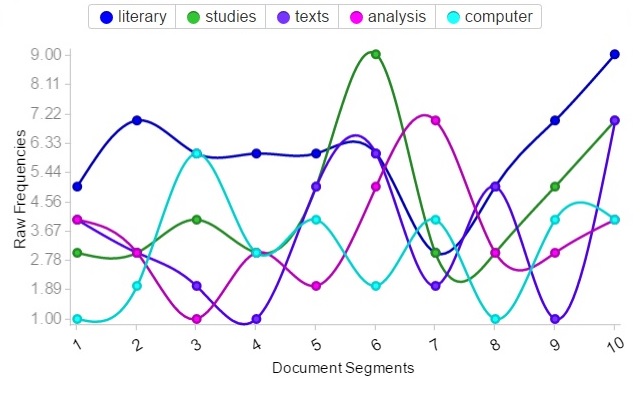 |
| Links: Literary | Literary highlighted with mouse, red links |
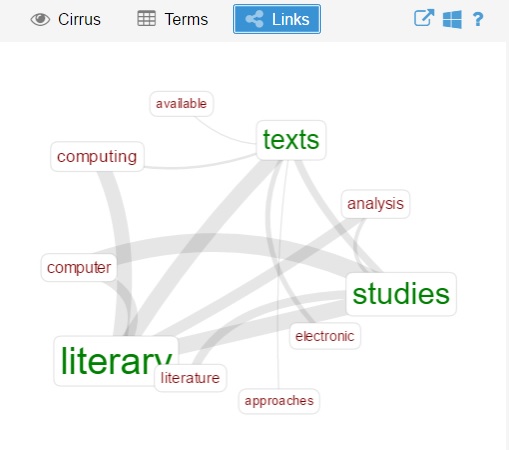 |
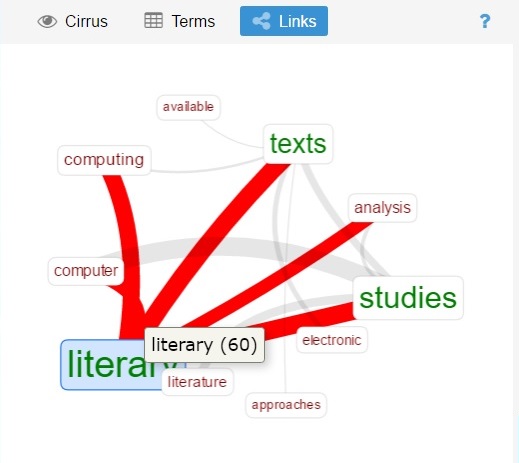 |
The links button on the Voyant panel shows Voyant’s analysis of Rommel’s article; clicking on a button shows the links it connects to, in this case when the Literary button is clicked the connecting links turn red. Click another button to see what the links are for it.
In summary, we have read about digital humanities, UNIX and race through the lenticular parallel structure. Programmers and technical people should recognize the modularity concepts, software reusability, and standards and rules for software development. Feminism makes us aware that the personal and the political are separate spheres; laws are made in the public sphere and can be changed there, e.g., segregation which separated people by color and race. Social justice activists work to break these barriers from inside and outside the system. Feminism is for everyone, not just for a certain class of white women. Women’s and gender studies coursework helps to identify axes of oppression, e.g., race, class, gender, and to work out a plan to change those things for the better.
McPherson discusses the mid 1960s, and movements during those years. Peggy McIntosh has spoken out, raised awareness, by writing to the educated in a recognizable way, to open the eyes of ‘other white people,’ many who are unaware that their smooth path has obstacles for others who are non-white. She calls attention by giving examples of what she can do because she is white that many non-whites cannot. Other people, white people, need to become aware. McPherson makes points in a different way than McIntosh has, to a different audience. McPherson speaks to a broad audience and uses a DH analysis using computational tools, UNIX operating system and connects it to the racial system. McIntosh uses humanities, academic essay approach, perhaps only seen by academics and students.
When the dominant group speaks for all and “control the turf”, the full solution to anything cannot be reached as the dominant group serves itself. First we saw this is about class division as a particular class is able to attend university or college. Second, it is about course division, or silos, as the technical classes were separated from the humanities. Third we see that explicit race oppression such as segregation has may have stopped in that form but is hidden as implicit oppression and therefore subversive. McPherson and McIntosh are seeking change. A good development is the intersection of technology and humanities in DH. There are obstacles which need to be removed for entrance for non-white students into DH. This work is not done until there is no longer the question “Why are the digital humanities so white?”
Works Cited
Brym, Robert J. New Society, Sociology for the 21st Century. 2nd Ed. Toronto, Canada: Harcourt Brace Company Canada Ltd, 1998.
Crow, Barbara A. and Lise Gotell, Eds. Open Boundaries, A Canadian Women’s Studies Reader. 3rd Ed. Toronto, Canada: Pearson Canada Inc. 2009.
DiMaggio, Paul, Eszter Hargittai, Coral Celeste, and Steven Shafer. “Digital Inequality, From Unequal Access to Differential Use” in The Inequality Reader, eds. David B. Grusky and Szonja Szelenyi. Boulder, Colorado: Westview Press, 2007: 549-566.
Henslin, James M., Dan Glenday, Ann Duffy, Norene Pupo. Sociology, a down-to-earth-approach. 4th Canadian Ed. Toronto, Canada: Pearson Education Canada, 2007.
McIntosh, Peggy. “White Privilege: Unpacking the Invisible Knapsack” https://www.pcc.edu/resources/illumination/documents/white-privilege-essay-mcintosh.pdf accessed March 3, 2017. From McIntosh, Peggy. White Privilege and Male Privilege: A Personal Account of Coming to See Correspondences Through Work in Women’s Studies. Wellesley, MA: Wellesley College, Center for Research on Women, 1988. Print.
McPherson, Tara. 2012 Print Edition. “Why Are the Digital Humanities So White? or Thinking the Histories of Race and Computation” http://dhdebates.gc.cuny.edu/debates/text/29 accessed March 3, 2017.
Mills, C. Wright. “The Power Elite” in The Equality Reader, eds. David B. Grusky and Szonja Szelenyi. Boulder, Colorado: Westview Press, 2007: 87-98.
Rommel, Thomas. A Companion to Digital Humanities, ed. Susan Schreibman, Ray Siemens, John Unsworth. Oxford: Blackwell, 2004. http://www.digitalhumanities.org/companion/
Reference digital humanities companion
https://en.wikipedia.org/wiki/Digital_humanities
https://en.wikipedia.org/wiki/Unix_philosophy